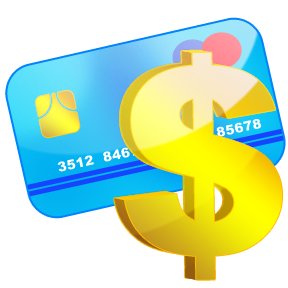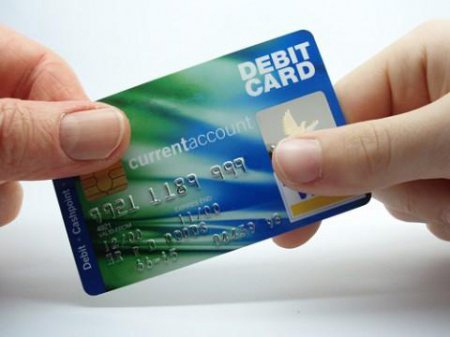What is a debit card? This is a payment instrument in the usual "plastic" format issued by banks. The transactions of money transactions through them, as a rule, are carried out by the largest international systems - VISA, MasterCard (or their Russian counterparts - such as, for example, PRO100).

Map in theory
Cards are designed for electronic payments (through acquiring terminals or online forms of online stores), as well as for withdrawing cash flow at ATMs (or through the operator of the issuing financial institution). We said that a debit card is a "payment instrument." This means that it is not a separate bank account, but merely tied to it.
Credit and overdraft
A very close debit plastic payment instrument is a credit card. Both of them are called upon to fulfill the same functions. But there is also a fundamental difference: when paying for purchases with a debit card, you can only operate with money actually available on the linked bank account. In turn, using credit cards, you can use not only your own, but also borrowed (issued by the card issuing bank) funds.
Various "hybrid" options are possible. Some types of debit "plastic" are still endowed with the ability to appeal to borrowed funds, but not credit, but in the form of an overdraft. What is the difference? What is this very overdraft, access to which opens a debit card? What is it - isn't it a loan? It turns out that no. An overdraft is a short-term loan (it must be repaid, as a rule, within a few days) and rather expensive to service a loan (rates reach hundreds percent per annum). In turn, there are credit cards with the so-called "zero limit", in which it is impossible to go into the "minus" at the expense of borrowed funds.

According to many experts, the boundaries between the concepts of "debit" card and "credit" confidently disappear. They were pronounced (if we talk about Russia) in the years when bank loans were not as popular as in our time. Many banks have now completely stopped dividing "plastic" into these two types, issuing, in fact, only credit cards - either with a "zero" limit, turning them into debit cards, or those that allow you to pay off debt.
Is it possible to say about a tool such as a debit card that it is a hopelessly outdated product? Probably not. If only because in the modern market there is still a small number of banks practicing, in turn, a very strict division between the two types of "plastic". Such financial institutions may provide the client with a debit card with a strict prohibition of overdraft and at the same time issue a credit card on which the borrower will not be able to put his own money. But such a policy, economists admit, is rare in the Russian banking system.
Choosing a debit card
There are several criteria that experts recommend focusing on when choosing a bank issuing a debit "plastic." The first is the map level. In today's banking practice, the four types of "plastic" are most common: instantly emitted (popularly called "nameless"), electronic, classic, and premium. What is each of them?
Instant Cards
Instantly issued cards (sometimes they are called in the English manner - instant) are issued by the bank literally at the time of the client’s request, right there, in the “window”.Their feature (which gave the reason to call them "nameless") is that the name of the owner is not displayed on their surface.
This significantly limits the possibility of using such cards (in particular, they cannot be used to pay on the Internet). But, at the same time, this kind of “tool” remains in demand. As a rule, it is issued in addition to cards of more prestigious categories (we will talk about them below).
Pluses of instantly issued cards: almost always they are free (however, the bank can charge a fee for operations with them), they are quick to produce. Cons: limited compatibility with ATMs of third-party financial institutions (especially if the card holder is abroad) and low protection against fakes (cards of this type, as a rule, are not equipped with an encryption chip).
Electron cards
What is the so-called electronic "plastic" (sometimes called electron)? This type of card, in turn, contains the name and surname of the holder on the surface. But the functionality of these products, as well as in the case of the "plastic" of the previous type, is quite limited. Employer companies most often supply their employees with such a debit card. salary projects.
Advantages of electronic "plastic": personification, the presence (usually) of an encryption chip. Cons: you cannot make purchases on the Internet, ATMs of non-native financial organizations are not always loyal to such cards. In addition, electronic "plastic", unlike the previous product, is not free (annual maintenance will cost about 200-300 rubles.).
Classic cards
The most popular debit cards are classic. Their functionality is wider than in the previous categories. With the help of "classics" you can perform the same operations as when using the "electron", as well as make payments via the Internet.
Pros: personification, without fail - a chip, functionality, compatibility with almost any ATM in the world. Cons: a relatively high cost of maintenance (about 800-1000 rubles per year), a sufficiently long production period (a week or two).
Premium Cards
Premium debit cards are mainly issued in order to emphasize the high status of the holder. There is no fundamental advantage in functions of this type of plastic over the same classic debit cards. In some cases, premium owners are offered discounts and special offers in restaurants, hotels, and cultural venues in different countries of the world.
Pros: personification, prestige, possible discounts and preferences. The main minus is the high cost of maintenance (about 5-10 thousand rubles per year).

VISA or MasterCard?
Does the payment system through which transactions will be carried out matter? As we said above, the two largest global financial operators are VISA and MasterCard. If we own a debit card from Sberbank, VTB24, or Bank of America, we will be served by one or the other system. The technological capabilities of these corporations are almost identical. Whatever system a particular debit card is controlled by, the feedback from the customers of the bank that issued it, in the last resort, is whether there is a VISA or MasterCard badge on the plastic surface.
The cards they serve are accepted in almost all countries of the world. Therefore, according to most experts, none of the companies has a clear advantage over the other. You can select cards served by any system.
Choose a bank
Having decided on the level of the debit card, we will move on to the next stage - the search for the issuer who will offer us the release of “plastic” on the most favorable terms. Do we decide to use a Sberbank debit card or prefer a product from a smaller financial institution?
Experts advise to pay priority attention to the following nuances.
1. The scale of the bank, reputation, "hype"
It is desirable that the financial institution has signs of sustainability. In order not to have a situation when the cardholder is abroad and the bank’s license is suddenly revoked, as a result of which the “plastic” is no longer serviced. Of course, in this case, the same Sberbank is out of competition. But we will consider other criteria.
2. The rates for opening an account and the cost of service
Despite the fact that there is great competition in the banking market, the principles for determining the price of services related to the issue of cards between different financial institutions can vary greatly. It happens that at the offices of two banks located across the road, the rates for issuing and servicing debit cards are correlated in multiple proportions.
3. The amount of fees for cash withdrawals at ATMs of various types (and most importantly - transparency of the conditions for their accrual)
This is the most important criterion. It is usually possible to withdraw cash without a commission only at an ATM owned by the card issuer (and most often only in their region). If the owner of the "plastic" went somewhere, then the costs of cashing out cash can be a significant waste for his personal budget. Therefore, we demand from the bank documents detailing the "commission" policy.
4. Additional privileges
Modern banks, as a rule, allow debit card holders to take advantage of various bonus options. Among the most popular is the calculation of interest per annum (for the amount placed on the account), as well as the cashback option (return of a part of the funds spent when paying for goods).
The most generous banks
Consider several attractive offers regarding debit cards from well-known financial and credit organizations.
A rather interesting option is offered by the TCS bank. Many Russians like the procedure itself, during which a Tinkoff debit card is issued: the fact is that you do not need to go to any office. It is enough to leave a request online, and when the “plastic” is ready, the courier will call and offer to meet in a place convenient for the client.

By issuing a card for a period of 3 years, TKS Bank replaces a monthly subscription fee for servicing an account in the amount of 99 rubles. (which, at first glance, is quite expensive for the market) provides a wide range of additional features. Firstly, this is an accrual of 10% per annum on the amounts that the cardholder deposits into the account. Secondly, the Tinkoff debit card has attractive cashback terms.
If the client is interested in issuing an “unnamed card”, then those that the “Russian Standard” offers (the product “Bank in your pocket”) are seen as very favorable conditions. In accordance with generally accepted standards on the market, this type of “plastic” is issued and maintained by the organization for free. In addition, many customers are likely to be attracted by the long validity of cards - 5 years. As in the case of TCS, Russian Standard Bank is ready to charge 10% per annum on the amount that the client deposits into the account.
If a person is interested in a "compromise" tariff, which implies inexpensive registration of a name card, he will like the products from Promsvyazbank (debit card "Good mood"). We note right away that the first year of servicing "plastic" as part of this offer is free, although even from the second the tariff is not very expensive - 200 rubles. The card is valid for 3 years, 4% per annum is charged.
Famous Brand Policy
Experts note that the largest banks in the country - Sberbank and VTB24 - are not too inclined to offer customers such a privilege as interest per annum. They have a cashback option in certain varieties (the SB of the Russian Federation has the "Thank you from Sberbank" program). Both financial organizations are very actively developing their lending business, including actively promoting plastic-based products. By the way, in the eyes of many SB and VTB customers, debit cards, according to experts, are actually identified with credit cards. They are so similar - both in terms of design, and even in appearance.

It often happens that a person who visits the bank’s office, consultants immediately offer a credit card. But at the same time, debit cards continue to be issued by Sberbank and VTB. These organizations, economists believe, attract people primarily by their stability, as well as by their wide network of ATMs.








